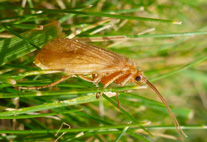Abstract
New species are described from the genera Consorophylax and Anisogamus (Trichoptera, Limnephilidae, Limnephilinae, Stenophylacini). Additionally the larva of the genus Anisogamus, and the larval stages of Anisogamus waringeri sp. nov. and A. difformis (McLachlan 1867) are described. The new species Consorophylax vinconi sp. nov. is a microendemic from the Southern Alps and differs from its congeners in the shape of the parameres, which are distinctly straitened in the distal quarter in the new species. The new species Anisogamus waringeri sp. nov. represents the second species in the hitherto monospecific genus Anisogamus. Compared to Anisogamus difformis, the male of A. waringeri sp. nov. has more-slender superior appendages; a more-rounded basal plate of the intermediate appendages, lacking pointed protuberances; and parameres shorter than the aedaegus, proximally with one dorsal and several ventral tines. Further, the two species are disjunctly distributed in the European mountain ranges (A. difformis: Alps, A. waringeri sp. nov.: Pyrenees). Larvae of species in the genus Anisogamus are characterized by the lack of a dorsal protuberance on abdominal segment I, a unique feature among Eurasian Limnephilidae. Anisogamus difformis and A. waringeri sp. nov. larvae differ in pronotum shape. The discovery of two new species demonstrates the significance of taxonomic studies in Europe, and the importance of adequate training for young scientists in order to assess an incompletely described biodiversity under threat of extinction.

